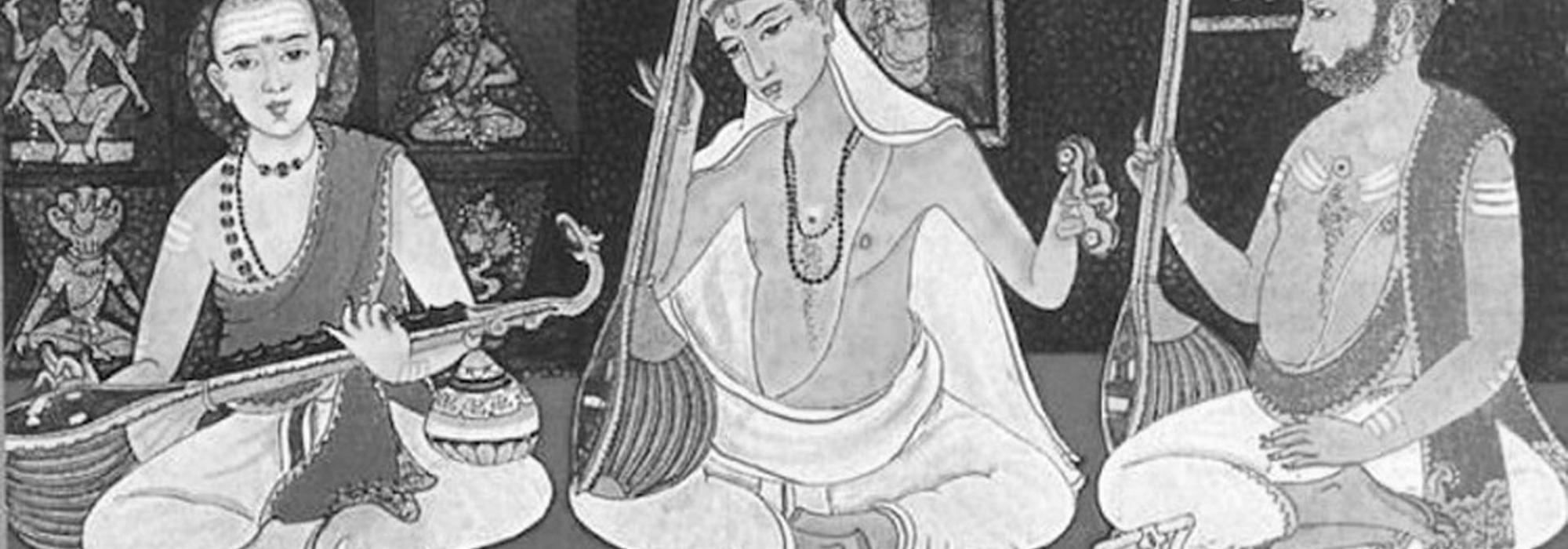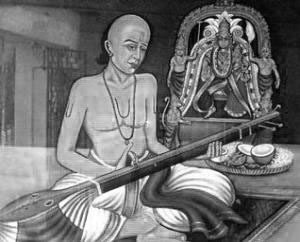Prekshaa is glad to bring out a special two-part article on the occasion of Tyāgarāja Ārādhana 2018, which falls on January 6th this year. This also happens to be Tyāgarāja's 250th birth anniversary year. — Editors
Śrī Tyāgarājāya Namaḥ
vyāso naigama-carcayā mrudugirā valmīka-janmā muniḥ
vairāgye śuka eva bhaktiviṣaye prahlāda eva svayaṃ |
brahmā nārada eva cāpratimayoḥ saṅgīta-sāhityayoḥ
yo rāmamṛtapāna-nirjita-śivastaṃ tyāgarājam bhaje ||
Thus goes the verse composed by Walajapet Venkataramana Bhagavatar in praise of his guru Tyāgarāja, likening him to Vyāsa, Vālmīki, Śuka, Prahlāda, Brahmā, Nārada, and Śiva. Without doubt, Tyāgarāja is the most popular composer among laymen and scholars alike and his compositions are heard most often in South Indian classical music concerts. Tyāgarāja’s musical compositions are so varied and diverse that if one learns only Tyāgarāja kṛtis, one can acquire discernment in the study of music, get a glimpse into Indian philosophy, luxuriously bathe in the great ocean of devotion, and—needless to say—perform hundreds of concerts without repeating a single composition.
Tyāgarāja was born as the third son of Rāmabrahma and Sītamma in 1767. He seems to have naturally acquired an interest in music as well as devotion to Rāma. He hails Rāma as his ‘kula-dhanamu’ (family wealth). While he was still a young boy, he impressed Vidvān Sonti Venkataramanayya with his singing and the renowned musician made Tyāgarāja his disciple. Soon, the young Tyāgarāja started composing his own kṛtis. Namo namo raghavāya anisham was his first kṛti, set in Deśīya-toḍi. As he grew up as a musician, he also blossomed into a gifted composer and offered the music world a treasure trove of compositions that are cherished for centuries the world over. From his grandfather—some say from Sage Nārada himself—he obtained the treatises Nāradīyam and Svarārṇavam. This furthered his musical research and enabled him to compose in rāgas hitherto unknown and unheard.
The Purpose of his Music
All of Tyāgarāja’s feelings and experiences – his devotion and blessedness, his view of good and bad, his wonder at the world in all its colours, his poverty and his wealth – find their place in his compositions. The wide range of emotions expressed in lilting Telugu exquisitely embellished with soulful notes is responsible for his great popularity. In his compositions, we find great variety in both sāhitya and saṅgīta. On the one hand, he has composed ekadhātuka kṛtis (like Kṣīrasāgaravihāra in Ānandabhairavi and Varalīlagānalola in Śaṅkarābharana) that have a simple tune and the same melody for the Pallavi as well as the Caraṇas; these can be learnt and sung by beginners and can also be sung as bhajans. On the other hand, there are kṛtis like Gati nīvani in Toḍi and O Raṅgaśāyi in Kāmbodhi, which require substantial musical erudition to perform. There is the joyous Haridāsulu veḍalu where he sings about Haridāsas going on their daily rounds and there is the poignant Nannu viḍaci kadalaku rā where he begs Rāma never to leave him. It doesn’t take much knowledge and erudition to understand his kṛtis; one only needs to know how to feel, and leave the rest to him. Not surprisingly, Tyāgarāja’s compositions are likened to drākṣāpāka (eating a grape; without the need of any peeling).[1] A parallel to Tyāgarāja in Sanskrit literature is of the Kavikulaguru Kālidāsa whose works are in the simple but profound vaidarbhī style.
As per tradition, Tyāgarāja is considered an incarnation of Tumburu, the celestial musician; aptly so, since Tyāgarāja also wandered with his tambūra singing the glory of Rāma. He considered himself a Haridāsa, a servant of Nārāyaṇa; his every waking moment was spent in the service of the almighty. He performed the japa of the Rāma-tāraka mantra ninety-six crore (close to a billion) times, which took about twenty-one years. Therefore, in his compositions, the sthāyī bhāva (dominant emotion) is that of bhakti. There is humour, mirth, distress, anger, longing, and peace, but all these feelings are adjunct to devotion, his music always employed in its service. He says, “Niddura nirākariñci muddugā tambūra baṭṭi śuddhamaina manasuce susvaramuto baddu tappaka bhajiñce bhaktapālanamu seyu,” meaning that the Supreme protects the devotee who sings in his praise forsaking sleep, holding the tambūra with love, and is without any reservations. In the famous Dhanyāsi kṛti, he asks, “Saṅgītajñānamu bhaktivinā sanmārgamu galade?”, making mock of musicians who view music as yet another way to earn riches and fame. For him, music was a mode of worship, a vehicle to reach jīvanmukti. In his famous Sāramati kṛti, he asks, “Saṅgītajñānavihīnulaku mokṣamu galadā?” (Is it possible to attain mokṣa without the knowledge of music?). In his Mukhāri kṛti, he says, “Saṅgīta śāstrajñānamu sārūpyasaukhyadame manasā” (O mind, the knowledge of music will give sārūpya mokṣa.[2])
He has composed many Utsava-sampradāya kṛtis marking different parts of daily worship, starting from Melukovayya (waking up the Lord) to Pūla pānpu mīda (putting Him to bed). Another set of kṛtis, the Divyanāma saṅkīrtanas are set to simple tunes and can be sung as bhajans. He also composed kṛtis praising the deities presiding over the tīrthakṣetras he visited; for example, the Lālguḍi pañcaratnam and Tiruvoṭṭriyūr tripurasundarī pañcaratnam.
Perhaps the most popular and scholarly of his kṛtis are the pañcaratna-kṛtis composed in the padavarṇa style. These kṛtis have a Pallavi, an Anupallavi and many Caraṇas for which both the svara and sāhitya are sung. These are composed in the five ghana-rāgas: Jagadānandakāraka in Nāṭa, Duḍukugala in Gauḻa, Sādhincene in Ārabhi, Kanakana rucirā in Varāḻi and Endaro mahānubhāvulu in Śrī. In these kṛtis, he has brought out the full grandeur of the ghana-rāgas. He has shown numerous variations in the tāna-like patterns in the svaras. These rhythmic patterns and sarvalaghu svaras make it easy for them to be sung in a group, even though they require considerable expertise.
Literary Excellence
Telugu lends itself to musical poetry, vying only with Sanskrit. Literary Telugu also borrows heavily from Sanskrit, making it easy to form new compounds. It is a language that can boast of distinct classicism even in its postmodern literature and yet can be understood by laymen. Telugu was the mother tongue of Tyāgarāja and it is only natural that a majority of his compositions are in that language. By virtue of the easy flow of his songs, Tyāgarāja ranks among the best lyrical poets. Some traditional Telugu scholars consider his Telugu to be of inferior quality; however, his felicity was more than sufficient to convey his emotions in all their glory. Further, his kṛtis were spontaneously and effortlessly composed while he was engaged in his devotional pursuits. In spite of this distraction, his works adhere to the rules of South Indian poetry. For instance, he always follows the dvitīyākṣara-prāsa (second-syllable rhyme). He also uses some tricky expressions in his kṛtis. In Rāma samayamu, he uses the epithet “yānta-bhānta-niśānta” for Rāmacandra. The letter ra comes after ya – therefore, yānta (ya + anta) is Rā; after bha comes ma and so bhānta (bha + anta) is ma; finally, niśānta is another name for the moon, candra! Similarly, in Jagadānandakāraka, he describes Rāma as “kalādharakalādharāpta.” Here, the first ‘kalādhara’ refers to the moon, and the second ‘kalādhara’ refers to Śiva, who wears (dharati) a phase (kalā) of the moon (kalādhara). In Melukovayya, he praises Rāma as “bharājanuta.” The use of ‘bharāja’ to refer to the moon is correct, but rarely used by earlier poets.
One can see various other poetic embellishments in Tyāgarāja’s works, the most common being alliteration or chekānuprasa (repetition of the same syllable or set of syllables) as seen in Sādhincene – “Paranārī-sodarāja-virāja-turāgarāja-rājanuta,” or in Rāma samayamu – “Kamanīya-guṇāntakāntaka-hitānta-rahita municintanīya vedāntavedya.” In other places, he uses the śleṣa (pun) to great effect. In the Aṭhāṇa kṛti Anupama guṇāmbudhi, he calls Rāma “Janakajāmāta,” which can mean Janaka-jāmātā (the son-in-law of King Janaka) or janakajā-māta (the Earth); vai in Telugu can mean either ‘being’ or ‘like,’ thus facilitating this pun. In the same kṛti, he uses “kanakapaṭa” to mean ‘golden cloth’ and ‘trickery.’ In some other compositions, he uses the dovetail effect in a line of verse, where the ending of the line can connect to its beginning, giving a different meaning. A fine example of this is seen in the Śuddha-sāveri kṛti, Dārini telusukoṇṭi. The first line of the Pallavi, Dārini telusukoṇṭi becomes Tripurasundarini telusukoṇṭi when it is sung for the second time. Similarly, in his Ārabhi composition Patiki maṅgaḻa hārati re, he ends each stanza with a word related to pati, forming the words Kosalapati, Sāketapati and so on.
Such literary ornamentation in extemporized poetry is possible only for people who have natural poetic flair. In Tyāgarāja, we see that this ornamentation is never at the cost of geyatva or musicality. He comes close to the celebrated Jayadeva in lyrical melody. Like Jayadeva, he doesn’t use double-consonant stresses unless absolutely required, and the words flow easily.
Following the path of Jayadeva and Narayana Tirtha, Tyāgarāja composed two geyarūpakas (musical dramas) – Prahlāda-bhakti-vijaya and Naukācaritram. As the name suggests, Prahlāda-bhakti-vijaya is the story of Prahlāda. Naukācaritram is a beautiful drama where Tyāgarāja’s grand poetic imagination comes to the fore. The story goes thus: The gopikās want to spend some time with the young Kṛṣṇa and take him on a boat ride. They are all proud of their beauty and think that Kṛṣṇa is enamoured of them. However, Kṛṣṇa has other plans for them and causes a storm. Stuck in the turbulent waters of the Yamunā, the women fear for their lives and take refuge in him. Kṛṣṇa relents, the storm abates and the chastised gopis return home. In these dramas, there are some fine kṛtis that have become extremely popular; for example, Śrī gaṇapatini in Saurāṣṭra, Vāsudevayeni veḍalina in Kalyāṇi, Gandhamu puyyarugā in Punnāgavarāḻi, Śṛngārincukoni in Suraṭi, etc.
To be concluded.
Thanks to Dr. T S Sathyavathi and Śatāvadhāni Dr. R Ganesh for their careful review and astute feedback. Edited by Hari Ravikumar.
Footnotes
[1] Among his contemporaries, the compositions of Śyāma Śāstri have been likened to kadalīpaka (eating a banana; the effort of peeling is necessary to enjoy it) and those of Muttusvāmi Dīkṣitar have been likened to nārikelapāka (eating a coconut; the hard shell has to be penetrated with much difficulty before the kernel can be enjoyed).
[2] Sārūpya is a kind of mokṣa where the devotee attains the form of the deity. The other forms of mokṣa are Sālokya (seeing the deity) and Sāyujya (merging with the deity).

















































Comments